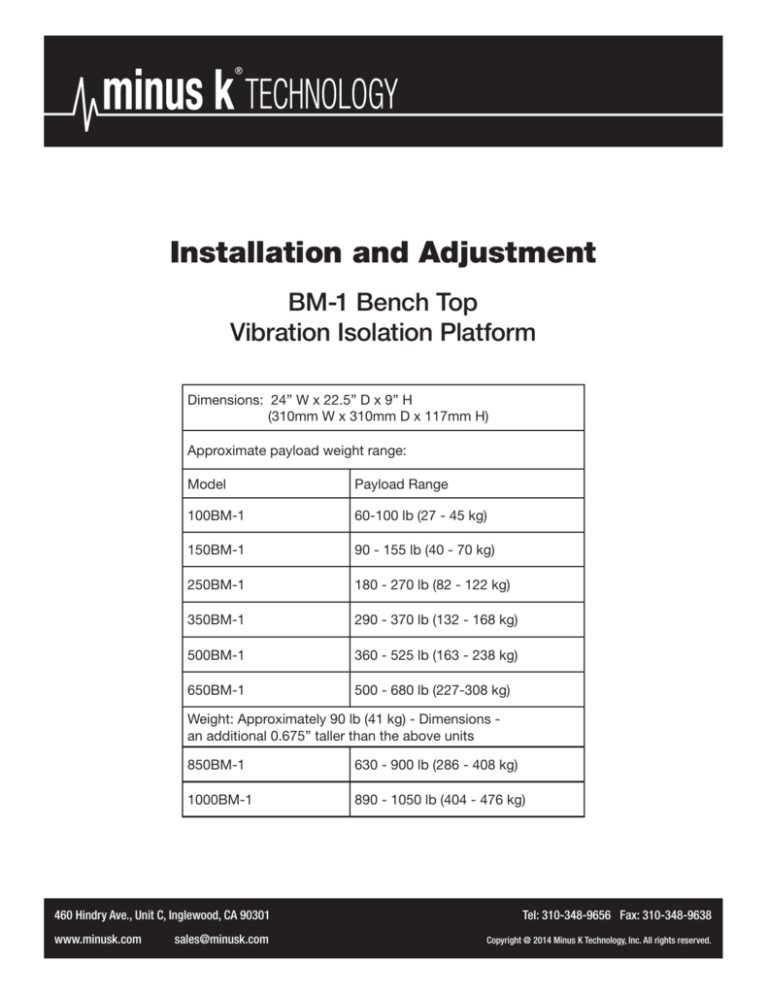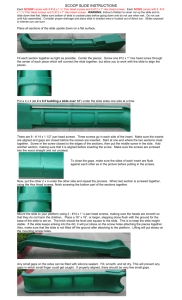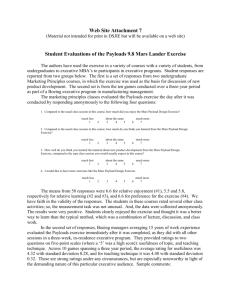
®
Installation and Adjustment
BM-1 Bench Top
Vibration Isolation Platform
Dimensions: 24” W x 22.5” D x 9” H
(310mm W x 310mm D x 117mm H)
Approximate payload weight range:
Model
Payload Range
100BM-1
60-100 lb (27 - 45 kg)
150BM-1
90 - 155 lb (40 - 70 kg)
250BM-1
180 - 270 lb (82 - 122 kg)
350BM-1
290 - 370 lb (132 - 168 kg)
500BM-1
360 - 525 lb (163 - 238 kg)
650BM-1
500 - 680 lb (227-308 kg)
Weight: Approximately 90 lb (41 kg) - Dimensions an additional 0.675” taller than the above units
850BM-1
630 - 900 lb (286 - 408 kg)
1000BM-1
890 - 1050 lb (404 - 476 kg)
460 Hindry Ave., Unit C, Inglewood, CA 90301
www.minusk.com
sales@minusk.com
Tel: 310-348-9656 Fax: 310-348-9638
Copyright @ 2014 Minus K Technology, Inc. All rights reserved.
®
BM-1 Bench Top
Vibration Isolation Platform
Installation and Adjustment
Required tools:
3/16 hex key
1/2 inch open-end wrench
1/2 inch socket wrench
B) Shipping Collar
C) Top Plate
B) Shipping Collar
B) Shipping
Collar
(removed)
H) Tilt Pad
D) Horizontal
Position
Indicator
A) Leveling Screw
E) Vertical Position
Indicator
A) Leveling Screw
G) Vertical
Stiffness
Adjustment
Screw
F) Load Adjustment
Crank
A) Leveling Screw
DO NOT REMOVE SHIPPING COLLARS UNTIL INSTRUCTIONS INDICATE. SHIPPING COLLARS MUST BE
USED WHEN MOVING ISOLATOR.
1. Make sure you have the correct model for your payload. Payload weight
MUST be within the recommended range.
(A)
2. Locate the three (3) leveling screws (A). Insert the leveling screws into the
bottom of the isolator and place on a solid, level surface. Place the bubble
level on the top plate and use the leveling screws to level the isolator.
3. Carefully position payload on top plate so its center-of-mass (CM) is as
close to center as possible.
4. Remove the four (4) red shipping collars (B). STORE SHIPPING
COLLARS IN A SAFE PLACE AS THEY MUST BE USED WHENEVER
MOVING ISOLATOR. Replace the screws into the holes to serve as
Horizontal Position Indicators.
CAUTION: If payload covers shipping collar holes, collars must be
removed before placing payload. Take extra care when placing payload without shipping collars attached. Do not replace screws as they
may interfere with payload.
(B)
5. Check the level of the top plate. The gap between the top plate and the
Isolator cover should be approximately equal on all sides.
6. Reposition the payload, as necessary, to level the top plate. It is
recommended that you re-install the red shipping collars if you need to
re-position the payload (see Step 3). However, it is not necessary if you
take extra care repositioning the payload. Do not use leveing screws to
level the top plate.
Gap
should be
equal on all
sides
NOTE: Cables, hoses, etc. connected to the payload can affect the
horizontal and vertical position. If possible make the following adjustment
without attaching the cables.
Floating Isolator Vertically
(F)
Incorrect
Incorrect
(E)
Correct Position
The isolator comes from the factory adjusted to support the nominal weight,
i.e., 100 lb for the 100BM-1, 150 lb for the 150BM-1, etc. Internal stops limit
vertical motion. The isolator must be “floated” between the stops.
7. Check Vertical Position Indicator (E). The pin should be approximately
centered on the horizon line. Turn Load Adjustment Crank (F) only clockwise
when pin is below the line, and only counterclockwise when it is above the
line. If the payload weight varies from nominal weight by a few pounds/
kilograms it may take many turns (approximately 10 turns per payload
pound/kilogram).
NOTE: To avoid damage never force the Load-Adjustment Crank. If pin
cannot be easily centered on line, turn Vertical Stiffness Adjustment
Screw slightly counterclockwise and readjust vertical position. Repeat
as necessary. This is a very sensitive adjustment. Turn the screw only
a few degrees each time.
Horizontal
Position
indicator
(D)
Floating Isolator Horizontally
8. Internal stops limit the horizontal motion. The Isolator must be “floated”
horizontally between the stops by adjusting the leveling screws. Horizontal
Position Indicator screws (D) should be approximately centered within holes.
Top View
Example: If screws are too far to the left of center, turn right leveling screw
clockwise (as viewed from above).
9. IF HORIZONTAL POSITION INDICATOR SCREWS ARE NOT VISIBLE,
check positioning by pushing the top plate gently front to back then side to
side. If it does not float freely and independently front to back and side to side
then adjust accordingly.
HORIZONTAL NATURAL FREQUENCY
1/2 Hz = 3 cycles in 6 secs.
10. The horizontal natural frequency can only be changed by varying the
payload weight. 1/2 Hz is achieved when payload is near nominal weight
(ie. 150 lb. for the 150BM-1). Increasing the weight lowers the frequency.
Decreasing the weight raises the frequency. Ballast weights can be used for
fine adjustments to frequency.
Check the horizontal frequency by pushing horizontally on the edge of top
plate to create small horizontal oscillations, then count cycles (one back and
forth movement). For example, 3 cycles in 6 seconds is 1/2 Hz. Depending
on the damping, the isolator may only cycle 2 or 3 times.
VERTICAL NATURAL FREQUENCY
1/2 Hz = 3 cycles in 6 secs.
11. Check the vertical frequency by pushing down vertically on top plate
to create small vertical oscillations, then count cycles (one up and down
movement). 1/2 Hz is equal to one cycle in 2 seconds.
The vertical natural frequency can be changed using the vertical stiffness
adjustment screw (G), although this adjustment is seldom necessary. This
adjustment requires a 1/2 inch socket wrench. Turning the screw clockwise
reduces the natural frequency, counterclockwise increases the frequency.
This is a sensitive adjustment. Turn only a few degrees each time then check
the vertical position and frequency. Adjust further, if necessary.
Note: Run any cables to the instrument with plenty of slack. Do not tie
cables together as this will make them stiffer. Stiff and taut cables can
stop the isolator from providing vibration isolation.






